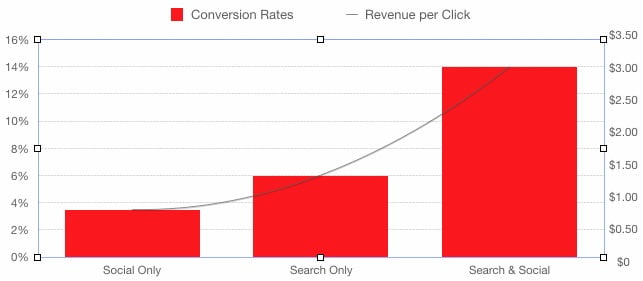As marketers, we know that the customer’s buying journey involves several channels along the path to conversion. From awareness to conversion, our messages need to follow buyers and stay with them. Integrating channels, especially search and social, leads to improved budgeting, bidding, targeting, and performance compared with isolated campaigns.
Paid search and social are both performance channels with particular strengths and weaknesses. For example, paid search captures buyer intent, whereas Facebook doesn’t. Facebook can open awareness to a huge new audience that AdWords can’t reach. LinkedIn offers the ability to target by job title, industry, and other specific criteria that the other platforms don’t offer.
Used intelligently together, paid search and social combine for a powerhouse cross-channel campaign.
Marin Software conducted a study of more than 200 enterprise advertisers managing Google, Bing, and Facebook campaigns, and examined conversion rates, revenue per click, and revenue per conversion for integrated and isolated search and social campaigns. Here is what the study found:
- More likely to buy. Users who click an advertiser’s search and social ads had approximately double the conversion rate of users who clicked only the search ad. The impact of cross-channel touch was even greater when examining social clicks: Users who clicked both the search and the social ads had a click-through rate approximately four-and-a-half times higher than users who clicked only social ads.
- More likely to spend more. Users who clicked both a search and a social ad contributed approximately twice as much revenue per click than users who clicked search ads only. Users who clicked both a search and a social ad contributed six times more revenue per click than users who clicked a social ad only.
- Increased revenue per click. Search campaigns managed alongside social advertising campaigns had double the revenue per click than search campaigns managed in isolation.
Considering the revenue implications of integrating search and social advertising, how can we get beyond the theoretical to actually integrating these two channels?
Here are three things to keep in mind to successfully integrate your search and social campaigns.
1. Run both channels
The first step toward integration is assessing your existing cross-channel marketing capabilities. Here are some sample questions to address in your assessment:
Are your search and social teams working toward the same objectives? Is your social marketing team focusing on fan acquisition while your search team is focusing on lead generation? Do your teams work together or in silos?
Are the message and value proposition consistent across channels? For example, is your social marketing team advertising a “low price” while your search marketing is advertising “high quality”? Conflicting messages may confuse the customer and dilute your message and brand.
Are your promotions aligned across channels? Are you launching and ending promotions simultaneously across channels, or letting them run independently? Running channel-specific promotions may cause confusion and frustration among customers.
Is your business intelligence strategy integrated? For example, are you looking at performance reports and making tactical decisions across channels, or are you limiting your business by managing each channel in a silo?
2. Reach the right audiences
Getting in front of the right audience is an essential component of any successful strategy, and the trick is identifying new ones. To start, you at least need some insight on where to begin testing.
To create a successfully integrated strategy, you must focus on the customer, not the channel. The goal is to reach the right customer with the right buying intentions at the right time. Taking an audience-centric approach to marketing focuses on targeting each customer across channels using a combination of intent (search query) and audience (customer profile) data.
Facebook is a great tool to increase your share of voice and brand awareness, because it gives you access to a huge audience. So if you’re not sure where to start, and you’re looking to increase brand awareness, Facebook might be a good first step.
Building an audience can happen on many different platforms, based on a multitude of attributes. You may want to simply retarget your site visitors who didn’t complete a purchase, or you may be looking to reach a more niche audience. Only you know the audience you are trying to reach.
3. Use relevant messaging
Once you’ve found the right audiences, you need to serve them the right messages. From awareness to conversion, the message you are trying to convey to your target audience should follow customers and stay with them.
Ensure your messages resonate with the right audience and context. Use insights from your highest-performing search ads to see what keywords and other messages you might want to repeat across channels.
Copy can be written for each specific audience, taking into account where they are in the customer funnel and not where you are engaging with them. For example, if you are targeting an interest-based audience, the copy should reflect the item someone has previously expressed an interest in. An ad targeted to competitors may highlight the points of difference between the brands. An ad targeted to purchases for the purpose of an upsell may emphasize specific high-value products.
* * *
There’s a clear synergy from running search and social together rather than in isolation, but it takes planning and effort. By syncing your messages with the target audience on the right platforms, you can increase performance and drive more leads.

